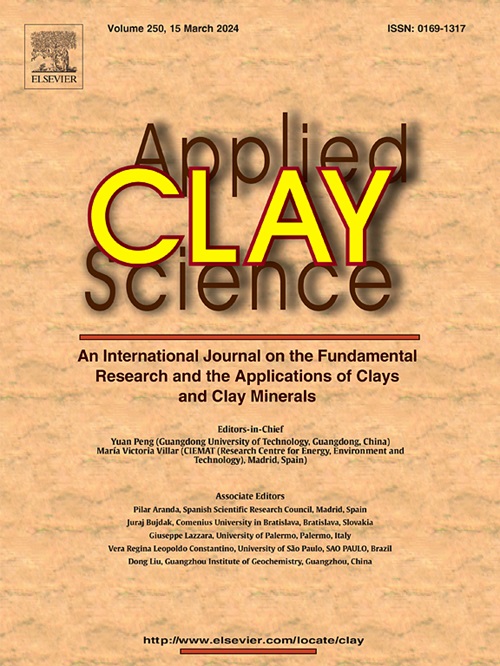温和条件下高岭石机械活化合成钠石
IF 5.3
2区 地球科学
Q2 CHEMISTRY, PHYSICAL
引用次数: 0
摘要
研究了在温和条件下机械活化对高岭石向苏打石转化的影响。研究了不同磨矿时间、不同碱浓度、不同浸出时间下高岭石碱浸法制备的钠石料。对所制备的沸石进行了物理、化学和形态表征。结果表明:球磨能显著降低高岭石的粒径,提高高岭石的比表面积;以高岭石为原料,在6 M NaOH条件下碱浸24 h,球磨2 h可制得高结晶的钠石(Na8Al6Si6O24(OH)2)。球磨破坏了高岭石的晶格,产生结构缺陷和位错,破坏了高岭石的骨架,提高了高岭石的反应活性。此外,机械活化的高岭石在碱性浸出下表现出混合转化,包括直接转化(高岭石→钠石)和两步转化(高岭石→沸石a→钠石),这取决于脱羟基化程度。与热活化高岭石一样,碱性浸出条件下,高岭石的完全脱羟基作用诱导了两步转化。在碱性条件下(≥4 M NaOH),高岭石直接转化为钠石,高岭石表面呈现非均相成核。有趣的是,在常压下,高岭石的热活化需要较高的碱浓度才能将A沸石转化为钠石,这体现了机械活化的优势。机械活化可以降低高岭石制备小苏打石所需的碱浓度,说明在温和的条件下可以完成小苏打石的制备。本文章由计算机程序翻译,如有差异,请以英文原文为准。
Mechanical activation of kaolinite for sodalite synthesis under mild conditions
This study investigated the effects of mechanical activation on the transformation of kaolinite to sodalite under mild conditions. The sodalite prepared via alkaline leaching of kaolinite under different milling times, alkaline concentrations, and leaching times was studied. The prepared zeolites were physically, chemically, and morphologically characterized. The results show that ball milling can significantly reduce the particle size and increase the specific surface area of kaolinite. Highly crystalline sodalite (Na8Al6Si6O24(OH)2) can be prepared from kaolinite with ball milling for 2 h after alkaline leaching at 6 M NaOH for 24 h. Ball milling destroyed the crystal lattice of kaolinite, generating structural defects and dislocations, destabilizing the framework of kaolinite and increasing its reactivity. Furthermore, mechanically activated kaolinite demonstrated a hybrid transformation under alkaline leaching, involving both direct transformation (kaolinite → sodalite) and a two-step transformation (kaolinite → zeolite A → sodalite), depending on the dehydroxylation degree. The complete dehydroxylation of kaolinite induced a two-step transformation under alkaline leaching, as the thermally activated kaolinite did. Kaolinite was directly transformed into sodalite under alkaline conditions (≥ 4 M NaOH), exhibiting heterogeneous nucleation on the surface of kaolinite. Interestingly, the conversion of zeolite A into sodalite required a higher alkaline concentration for the thermal activation of kaolinite under atmospheric pressure, reflecting the advantages of mechanical activation. Mechanical activation can reduce the alkaline concentration required for the preparation of sodalite from kaolinite despite the conversion route, indicating that the preparation of sodalite can be completed under mild conditions.
求助全文
通过发布文献求助,成功后即可免费获取论文全文。
去求助
来源期刊

Applied Clay Science
地学-矿物学
CiteScore
10.30
自引率
10.70%
发文量
289
审稿时长
39 days
期刊介绍:
Applied Clay Science aims to be an international journal attracting high quality scientific papers on clays and clay minerals, including research papers, reviews, and technical notes. The journal covers typical subjects of Fundamental and Applied Clay Science such as:
• Synthesis and purification
• Structural, crystallographic and mineralogical properties of clays and clay minerals
• Thermal properties of clays and clay minerals
• Physico-chemical properties including i) surface and interface properties; ii) thermodynamic properties; iii) mechanical properties
• Interaction with water, with polar and apolar molecules
• Colloidal properties and rheology
• Adsorption, Intercalation, Ionic exchange
• Genesis and deposits of clay minerals
• Geology and geochemistry of clays
• Modification of clays and clay minerals properties by thermal and physical treatments
• Modification by chemical treatments with organic and inorganic molecules(organoclays, pillared clays)
• Modification by biological microorganisms. etc...
 求助内容:
求助内容: 应助结果提醒方式:
应助结果提醒方式:


